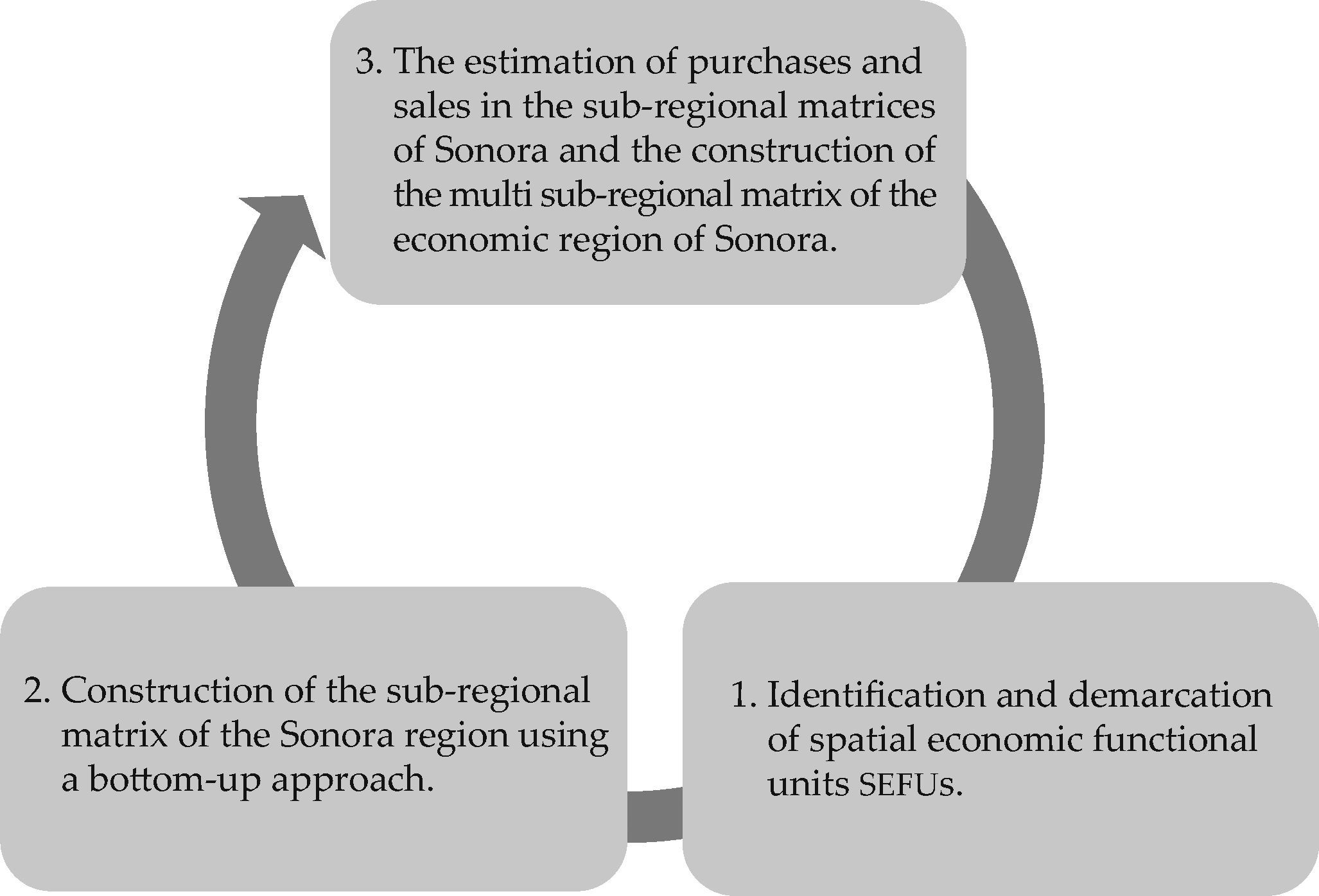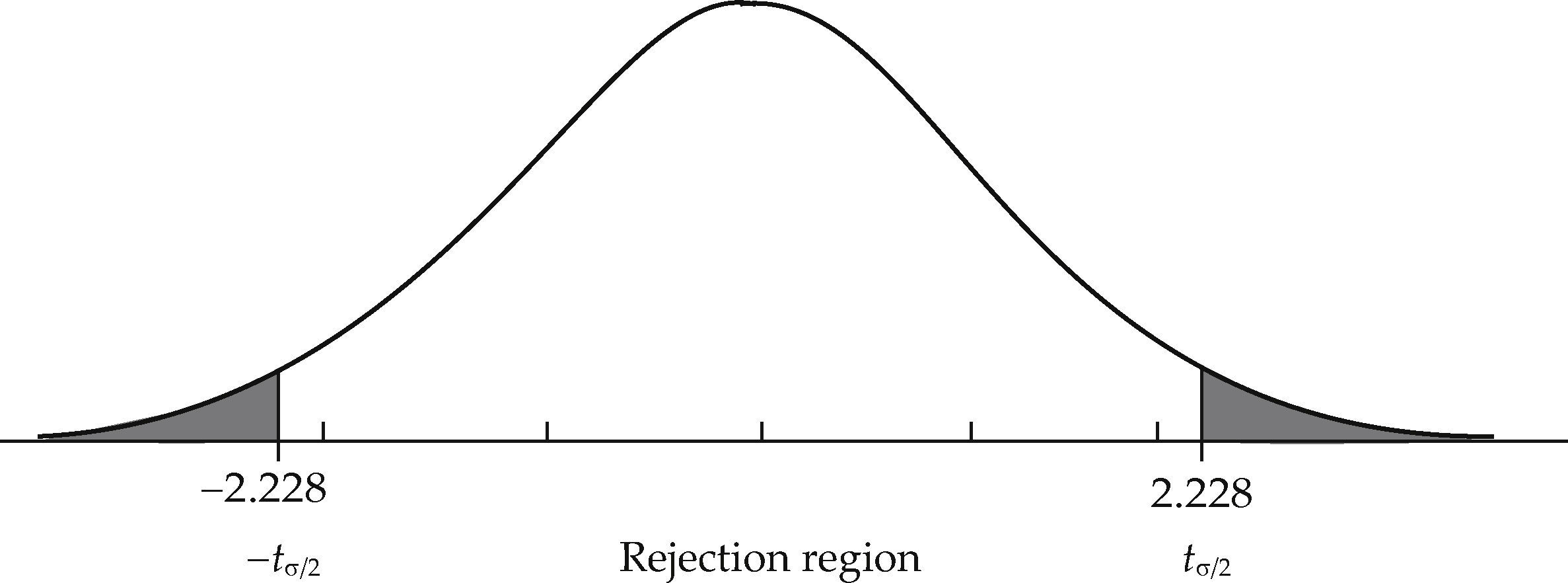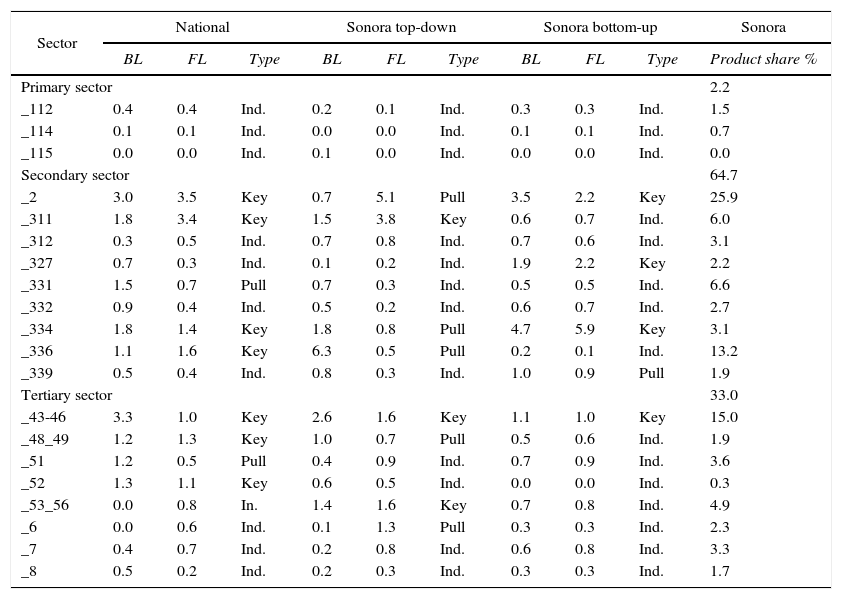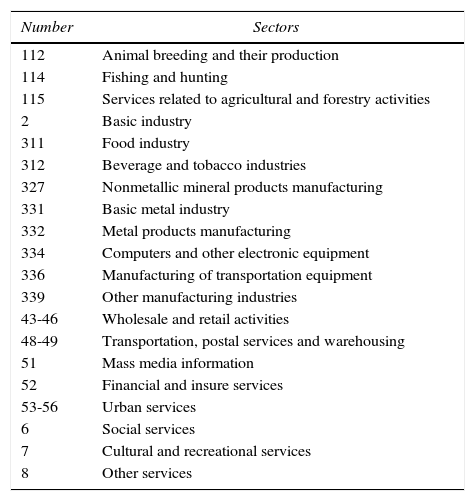The main purpose of this essay is to develop and implement a methodology for the construction of a regional input-output matrix using a bottom-up approach and compare it to the one made using a top-down approach, using as a case study the state of Sonora in México. We assume that the regional matrix, constructed with using a top-down approach, is inadequate for the comprehension of regional economic behavior and its structural economic and spatial attributes, and therefore it becomes necessary to rely on a bottom-up approach for the construction of regional input-output matrices.
Our main concern is to develop a bottom-up methodology for the construction of regional input-output matrices and to show differences and similarities with the top-down approach, through a statistical assessment based on the statistical association between census data of both regional and national economic structures. Therefore, the main outcomes of this research are: 1) a review of the main methodological features of the debate for the construction of a regional input-output matrix; 2) a methodological proposal for the construction of a regional input-output matrix, using a bottom-top approach, and 3) an statistical assessment of the main differences and similarities between the construction of regional input-output matrices using both approaches, using as a case study the state of Sonora, Mexico.
El objetivo principal de este ensayo es desarrollar y aplicar una metodología para la construcción de una matriz de insumo-producto regional con un enfoque de abajo hacia arriba y compararla con la construida mediante el enfoque tradicional de arriba hacia abajo, utilizando como caso de estudio el estado de Sonora en México. Suponemos que la matriz regional, elaborada mediante el uso de un enfoque de arriba hacia abajo, es inadecuada para la comprensión del comportamiento económico regional y sus atributos espaciales y estructurales; de ahí la necesidad de contar con un enfoque de abajo hacia arriba para la construcción de matrices de insumo-producto regionales.
Nuestro trabajo se orienta al desarrollo de una metodología de abajo hacia arriba para la elaboración de matrices de insumo-producto regional y mostrar las diferencias y similitudes con el enfoque de arriba hacia abajo a través de una evaluación estadística de los resultados basada en la asociación estadística entre la matriz regional y la nacional, comparando ambas metodologías. Por lo tanto, los principales resultados de esta investigación son: 1) una revisión de las principales características metodológicas del debate para la construcción de una matriz de insumo-producto de la región; 2) una propuesta metodológica para la elaboración de una matriz de insumo-producto de la región usando un enfoque de abajo hacia arriba, y 3) una evaluación estadística de las principales diferencias y similitudes entre la construcción de matrices de insumo-producto regionales empleando ambos enfoques, tomando como caso de estudio el estado de Sonora en México.
This essay is part of the Project papiit IN307114 “Clusters, cadenas productivas e identificación del potencial de integración productiva y del aprovechamiento de las ventajas competitivas de las regiones económicas de México” [“Clusters, Productive Chains and Identifying the Potential for Production Integration and Leveraging of the Competitive Advantages of the Economic Regions of Mexico”] supported by the Dirección General de Asuntos del Personal Académico at the Universidad Nacional Autónoma de México (dgapa-unam). This article comes after a previous one which presented the first phase for the implementation of the methodology: Normand Eduardo Asuad Sanén and José Manuel Sánchez Gambóa (2016). An exploratory and comparative analysis for the construction of regional input-output matrices between bottom-up and top-down approaches, in process of editorial review. We also want to express our recognition to students and Centro de Estudios de Desarrollo Regional y Urbano Sustentable (cedrus) member professors for their collaboration; without them, the creation of this article would not have been possible, particularly to Karina Garduño Maya, Krista Zafra García, Cristina Vázquez Ruiz, Marcos Maya Luis Alberto Flores, Alejandra Ibañez Tercero, Sergio Rodríguez, Francisco Alfredo García, and Adrian García. Furthermore, I am also very grateful to Dra. María Dolores Sánchez for its statistical comments and to Dr. William Sughrua and to William Ismael Sughrua Martínez for the English revision.
Presented in the 23th International Input-Output Conference in Mexico City, 2015: 1) Asuad, Vázquez, and Quiñones Luna (2015); 2) Asuad, Sánchez Gamboa, and Garduño (2015); 3) Maya, Sánchez, and Asuad (2015), and 4) Garduño, Sánchez, and Asuad (2015).
Presented in the 24th International Input-Output Conference in Seoul, Korea, 2016: 1) Garduño, Sánchez, and Asuad (2016); 2) Vázquez, Asuad, and Zafra (2016), and 3) Maya, Sánchez, and Asuad Sanén (2016).
Own elaboration with data published by the Instituto Nacional de Estadística y Geografía (inegi), available at: <www.inegi.gov.mx>. See gross domestic product by economic sector of economic activity 2008-2012, the Anuario Estadístico y Geografía de Sonora 2014, and México en cifras 2008.
It is worth mentioning that despite the comparison we made between the outcomes of both matrices using the entire political unity of the state of Sonora México, an absolute requirement for the comparison between both approaches, we believe this does not have any effect in how the regional I-O matrix was constructed, given that it originated from the spatial economic functional units (sefu) of Sonora, which as a whole integrate the political unity of Sonora.
This part was developed based on Brand (1997).
According to Sánchez Torres (2014, p. 135), Bonfilgio (2009) calculated a value of delta in 0.36 in 1 000 national matrices and 20 000 sub-regional matrixes, with a Monte Carlo's simulation statistical analysis.
In the regional and urban literature, there is a consensus on the concept of functional regions, which are defined as spatial units that result from the organization of economic and social relationships in space. Furthermore, theoretically, this concept has been treated through different perspectives: theory of location, theory of market areas, theories of poles of economic growth along with their respective debates in explaining urban territories, especially from Christaller (1933) and Losch (1944) as well as in current urban policy issues (e.g., oecd, 2002 and 2013). According to our conception, the essential aspect of functional economic regions is the identification of economic activities in space through its location and economic sectorial characteristics, as well as the role and interactions they establish, which give rise to a economic structure on space, and leads to the creation and development of an economic spatial unity (See Asuad Sanén, 2014, pp. 339-356). For the specific economic functions in a city, see McDonald (1997). However, there are different techniques for the identification and measurement of the economic spatial functional region: gravity models, labor market models and commercial interactions areas. Nevertheless, we have developed a methodology for the identification and analysis of these units and their economic interactions through the identification of the sub-regional productive chains, whose details are presented in appendices 1 and 2.
The multiplication is done element by element, so that each element had a corresponding weight according to weight calculated for the pair of corresponding sites. In other words, γij = (ABS)(x ij * ij) (Asuad Sanén, Quintana Romero, and Ramirez Hernández, 2008).
This section is based on Brand's consideration (2012) of the ras method as an estimator of regional trade.
Devore (1990) proposes seven steps for the realization of hypothesis testing: 1) identify the parameter of interest and describe it in the context of the problem; 2) determine the null value and set the null hypothesis; 3) set the appropriate alternative hypothesis; 4) Introduce the formula to obtain the values of the test statistic; 5) set the rejection region for statistical significance level α; 6) calculate the sample quantities, replace them in the formula and calculate the statistical value, and 7) decide if H0 is rejected and set conclusions in the context of the problem. Steps 2 and 3 must be performed before examining the data.
Research Professor at the Rutgers Economic Advisory Service (R/ECON™), Edward J. Bloustein School of Planning & Public Policy, Rutgers, The State University of New Jersey (United States of America). Correspondence: lahr@rutgers.edu.
Profesor de la Facultad de Economía, unam (México). Correspondencia: ruizna@unam.mx.
Profesores de la Universidad de Guadalajara. Correspondencia: doctoracallico@gmail.com.
El Dr. Michael Lahr es doctor en ciencia regional por la Universidad de Pensilvania y se ha distinguido en el campo como profesor e investigador en Edward J. Bloustein School of Planning & Public Policy Rutgers, The State Uhiversity of New Jersey, sobresaliendo sus trabajos sobre insumo-producto, además de contar entre sus distinciones profesionales por desempeñarse como Vicepresidente de la Asociación Internacional de Insumo-Producto y como Consejero de la Asociación Internacional de Ciencia Regional. Además de ser el Director del Servicio de Consultoría Económica de Rutgers y Editor Administrador de la revista The Review of Regional Studies de los Estados Unidos.
Profesor investigador de la Facultad de Economía de la unam, Doctor en economía por la New School for Social Research de Nueva York. Se ha distinguido entre otros trabajos por sus artículos sobre insumo-producto, contando como distinciones la organización de la 23 Conferencia Internacional de Insumo-Producto realizada en México en 2015, asimismo es miembro de la International Input-Output Association, de Sigma Xi The Scientific Research Society y de la Sociedad Hispanoamericana de Análisis Input-Output.
La doctora Josefina Callicó López y el maestro Evaristo Jaime González Robles son profesores de desarrollo económico y matrices de insumo-producto regionales en la Universidad de Guadalajara y fundadores de la especialidad en dicha Universidad, con amplia experiencia y trayectoria en el estudio y construcción de matrices de insumo-producto regionales.













